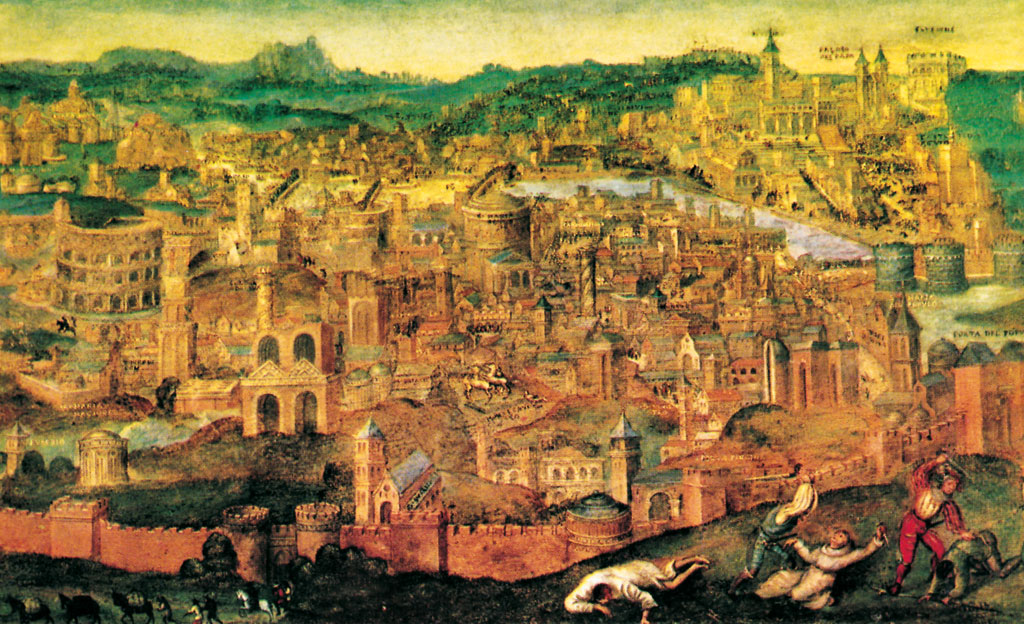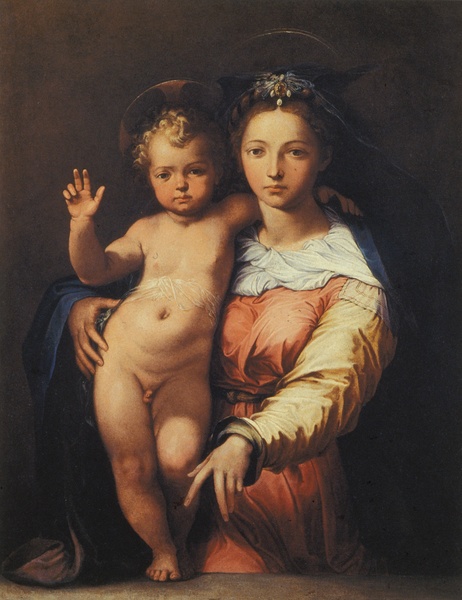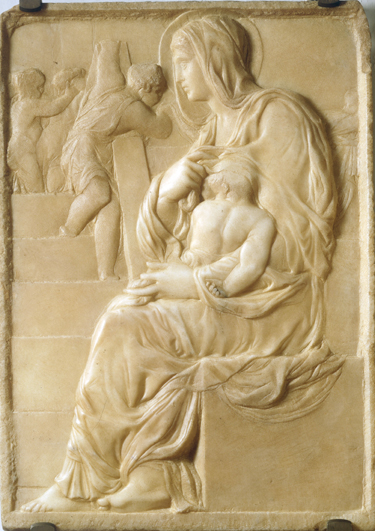|
Giulio Romano
Giulio Pippi ( – 1 November 1546), known as Giulio Romano and Jules Romain ( , ; ), was an Italian Renaissance painter and architect. He was a pupil of Raphael, and his stylistic deviations from High Renaissance classicism help define the sixteenth-century style known as Mannerism. Giulio's drawings have long been treasured by collectors; contemporary prints of them engraved by Marcantonio Raimondi were a significant contribution to the spread of sixteenth-century Italian style throughout Europe. Biography Giulio Pippi was born in Rome and he began his career there as a young assistant to the leading painter and architect Raphael. He became an important member of Raphael's large team working on the frescos in the Raphael Rooms and Vatican loggias using designs by Raphael and, later painting a group of figures in the '' Fire in the Borgo'' fresco. He also collaborated on the decoration of the ceiling of the Villa Farnesina. Despite his relative youth, increasingly ... [...More Info...] [...Related Items...] OR: [Wikipedia] [Google] [Baidu] [Amazon] |
Titian
Tiziano Vecellio (; 27 August 1576), Latinized as Titianus, hence known in English as Titian ( ), was an Italian Renaissance painter, the most important artist of Renaissance Venetian painting. He was born in Pieve di Cadore, near Belluno. Titian was one of the most versatile of Italian painters, equally adept with portraits, landscape backgrounds, and mythological and religious subjects. His painting methods, particularly in the application and use of colour, exerted a profound influence not only on painters of the late Italian Renaissance, but on future generations of Art of Europe, Western artists. His career was successful from the start, and he became sought after by patrons, initially from Venice and its possessions, then joined by the north Italian princes, and finally the Habsburgs and the papacy. Along with Giorgione, he is considered a founder of the Venetian school of Italian Renaissance painting. In 1590, the painter and art theorist Giovanni Paolo Lomazzo describe ... [...More Info...] [...Related Items...] OR: [Wikipedia] [Google] [Baidu] [Amazon] |
Fire In The Borgo
''The Fire in the Borgo'' is a painting created by the workshop of the Italian Renaissance artist Raphael between 1514 and 1517. Though it is assumed that Raphael did make the designs for the complex composition, the fresco was most likely painted by his assistant Giulio Romano. The painting was part of Raphael's commission to decorate the rooms that are now known as the '' Stanze di Raffaello'', in the Apostolic Palace in the Vatican. It depicts Pope Leo IV halting a fire in 847 with a benediction from a balcony in front of the Old St. Peter's Basilica Old St. Peter's Basilica was the church buildings that stood, from the 4th to 16th centuries, where St. Peter's Basilica stands today in Vatican City. Construction of the basilica, built over the historical site of the Circus of Nero, began dur .... The mural lends its name to the ''Stanza dell'incendio del Borgo'' ("The Room of the Fire in the Borgo"). References Further reading * * Raphael Rooms Paintings by Giul ... [...More Info...] [...Related Items...] OR: [Wikipedia] [Google] [Baidu] [Amazon] |
Curtatone
Curtatone (Emilian dialects, Mantovano: ) is a ''comune'' (municipality) in the province of Mantua, in the Italy, Italian region of Lombardy, located about southeast of Milan and about southwest of Mantua. The municipality of Curtatone is formed by the ''frazione, frazioni'' (subdivisions, mainly villages and hamlets) Buscoldo, Eremo, Grazie (site of the notable Santuario della Beata Vergine delle Grazie), Levata, Montanara (municipal seat), Ponteventuno, San Lorenzo, and San Silvestro. Curtatone borders the following municipalities: Borgo Virgilio, Castellucchio, Mantua, Marcaria, Porto Mantovano, Rodigo. Its ''frazione'' of Grazie is one of I Borghi più belli d'Italia ("The most beautiful villages of Italy"). Curtatone received the honorary title of city with a presidential decree on July 2, 2002. See also * First Italian War of Independence#Battle of Curtatone and Montanara (29 May 1848), Battle of Curtatone (1848) References External links Official website C ... [...More Info...] [...Related Items...] OR: [Wikipedia] [Google] [Baidu] [Amazon] |
Palladian Architecture
Palladian architecture is a European architectural style derived from the work of the Venetian architect Andrea Palladio (1508–1580). What is today recognised as Palladian architecture evolved from his concepts of symmetry, perspective and the principles of formal classical architecture from ancient Greek and Roman traditions. In the 17th and 18th centuries, Palladio's interpretation of this classical architecture developed into the style known as Palladianism. Palladianism emerged in England in the early 17th century, led by Inigo Jones, whose Queen's House at Greenwich has been described as the first English Palladian building. Its development faltered at the onset of the English Civil War. After the Stuart Restoration, the architectural landscape was dominated by the more flamboyant English Baroque. Palladianism returned to fashion after a reaction against the Baroque in the early 18th century, fuelled by the publication of a number of architectural books, including Pal ... [...More Info...] [...Related Items...] OR: [Wikipedia] [Google] [Baidu] [Amazon] |
Palazzo Te
, or simply , is a palace in the suburbs of Mantua, Italy. It is an example of the mannerist style of architecture, and the acknowledged masterpiece of Giulio Romano. Name The palace is mostly referred to by English-speaking writers, especially art historians, as . In Italian, the name is now commonly shortened to . It was originally named after , the suburb where it was built. The toponym is most likely derived from Lombard or , referring to a "linden grove" that once grew in the area, or alternatively from Latin "hut". Art historian Giorgio Vasari spelled the name , based on the now archaic Italian-language name of the letter T. History was constructed 1524–34 for Federico II Gonzaga, Marquess of Mantua, as a palace of leisure. The site chosen was that of the family stables which he had built at , on the edge of the marshes just outside Mantua's city walls, as early as in 1502. Giulio Romano, a pupil of Raphael, was commissioned to design the building. The ... [...More Info...] [...Related Items...] OR: [Wikipedia] [Google] [Baidu] [Amazon] |
Sack Of Rome (1527)
The Sack of Rome, then part of the Papal States, followed the capture of Rome on 6 May 1527 by the mutiny, mutinous troops of Charles V, Holy Roman Emperor, during the War of the League of Cognac. Charles V only intended to threaten military action to make Pope Clement VII come to his terms. However, most of the Imperial Army (Holy Roman Empire), Imperial army (14,000 Germans, including Lutherans, 6,000 Spaniards and some Italians, Italians) were largely unpaid. Despite being ordered not to storm Rome, they broke into the scarcely defended city and began looting, killing, and holding citizens for ransom without any restraint. Clement VII took refuge in Castel Sant'Angelo after the Swiss Guard were annihilated in a delaying rear guard action; he remained there until a ransom was paid to the pillagers. Benvenuto Cellini, eyewitness to the events, described the sack in his works. It was not until February 1528 that the spread of a plague and the approach of the League forces unde ... [...More Info...] [...Related Items...] OR: [Wikipedia] [Google] [Baidu] [Amazon] |
Duchy Of Mantua
The Duchy of Mantua (; ) was a duchy in Lombardy, northern Italy. Its first duke was Federico II Gonzaga, member of the House of Gonzaga that ruled Mantua since 1328. In 1531, the duchy also acquired the March of Montferrat, thanks to the marriage between Gonzaga and Margaret Paleologa, Marchioness of Montferrat. The duchy's historic power and influence under the Gonzaga family made it one of the main artistic, cultural, and especially musical hubs of Northern Italy and the country as a whole. Mantua also had one of the most splendid courts of Italy and Europe in the fifteenth, sixteenth, and early seventeenth centuries. In 1708, after the death of Ferdinando Carlo Gonzaga, the last heir of the Gonzaga family, the duchy was partitioned. The domains were divided between the House of Savoy, that obtained the remaining half of Montferrat, and the House of Habsburg, that obtained the city of Mantua itself. History Background After the fall of the Western Roman Empire, Man ... [...More Info...] [...Related Items...] OR: [Wikipedia] [Google] [Baidu] [Amazon] |
Baldassare Castiglione
Baldassare Castiglione, Count of Casatico (; 6 December 1478 – 2 February 1529),Dates of birth and death, and cause of the latter, fro, ''Italica'', Rai International online. was an Italian courtier, diplomat, soldier and a prominent Renaissance author. Castiglione wrote ''Il Cortegiano'' or ''The Book of the Courtier'', a courtesy book dealing with questions of the etiquette and morality of the courtier. It was very influential in 16th-century European court circles. Biography Castiglione was born in Casatico, near Mantua (Lombardy) into a family of the minor nobility, connected through his mother Luigia Gonzaga, Luigia to the ruling House of Gonzaga, Gonzagas of Mantua. In 1494, at the age of sixteen, Castiglione was sent to Milan, then under the rule of Duke Ludovico Sforza, to begin his Renaissance humanism, humanistic studies at the school of the renowned teacher of Greek and editor of Homer Demetrios Chalkokondyles (Latinized as Demetrius Calcondila), and Georgius Mer ... [...More Info...] [...Related Items...] OR: [Wikipedia] [Google] [Baidu] [Amazon] |
Giorgio Vasari
Giorgio Vasari (30 July 1511 – 27 June 1574) was an Italian Renaissance painter, architect, art historian, and biographer who is best known for his work ''Lives of the Most Excellent Painters, Sculptors, and Architects'', considered the ideological foundation of Western art history, art-historical writing, and still much cited in modern biographies of the many Italian Renaissance artists he covers, including Leonardo da Vinci and Michelangelo, although he is now regarded as including many factual errors, especially when covering artists from before he was born. Vasari was a Mannerist painter who was highly regarded both as a painter and architect in his day but rather less so in later centuries. He was effectively what would now be called the minister of culture to the Medici court in Florence, and the ''Lives'' promoted, with enduring success, the idea of Florentine superiority in the visual arts. Vasari designed the ''Tomb of Michelangelo'', his hero, in the Santa Croce, Fl ... [...More Info...] [...Related Items...] OR: [Wikipedia] [Google] [Baidu] [Amazon] |
Federico II Of Gonzaga
Federico II of Gonzaga (17 May 1500 – 28 August 1540) was the ruler of the Italian city of Mantua (first as Marquis, later as Duke) from 1519 until his death. He was also Marquis of Montferrat from 1536. Biography Federico was son of Francesco II Gonzaga, Marquess of Mantua and Isabella d'Este. Due to the turbulent politics of the time, from the age of ten, he spent three years as a hostage in Rome under Pope Julius II. From 1515 to 1517, Federico was the hostage of King Francis I of France, to ensure Gonzaga assistance in Italy. On 3 April 1519, Federico succeeded his father as Marquis of Mantua, initially under the regency of his mother and his uncles Sigismondo and Giovanni Gonzaga. He received the imperial investiture from emperor Charles V on 7 April 1521. Pope Leo X named him Captain General of the Church (commander in chief of the Papal Army) in July 1521, and he fought against the French at Parma in 1521 and at Piacenza in 1522. Federico signed a marriage contract with ... [...More Info...] [...Related Items...] OR: [Wikipedia] [Google] [Baidu] [Amazon] |
Perino Del Vaga
Piero Bonaccorsi (1501 – October 19, 1547), known as Perino (or Perin) del Vaga, was an Italian painter and draughtsman of the Late Renaissance/Mannerism. Biography Perino was born near Florence. His father ruined himself by gambling, and became a soldier in the invading army of Charles VIII. His mother died when he was but two months old; but shortly afterwards he was taken up by his father's second wife. Perino was first apprenticed to a druggist, but soon passed into the hands of a mediocre painter, Andrea de' Ceri,Noted in Vasari's biography. and when eleven years of age, of Ridolfo Ghirlandaio. Perino was one of Ghirlandaio's most talented pupils. Another mediocre painter, Vaga from Toscanella, undertook to settle the boy in Rome. Perino, when he at last reached Rome, was utterly poor, and with no clear prospect beyond journey-work for trading decorators. He was eventually entrusted with some of the subordinate work undertaken by Raphael in the Vatican. He assisted ... [...More Info...] [...Related Items...] OR: [Wikipedia] [Google] [Baidu] [Amazon] |
Michelangelo
Michelangelo di Lodovico Buonarroti Simoni (6March 147518February 1564), known mononymously as Michelangelo, was an Italian sculptor, painter, architect, and poet of the High Renaissance. Born in the Republic of Florence, his work was inspired by models from classical antiquity and had a lasting influence on Western art. Michelangelo's creative abilities and mastery in a range of artistic arenas define him as an archetypal Renaissance man, along with his rival and elder contemporary, Leonardo da Vinci. Given the sheer volume of surviving correspondence, sketches, and reminiscences, Michelangelo is one of the best-documented artists of the 16th century. He was lauded by contemporary biographers as the most accomplished artist of his era. Michelangelo achieved fame early. Two of his best-known works, the ''Pietà (Michelangelo), Pietà'' and ''David (Michelangelo), David'', were sculpted before the age of 30. Although he did not consider himself a painter, Michelangelo created ... [...More Info...] [...Related Items...] OR: [Wikipedia] [Google] [Baidu] [Amazon] |








